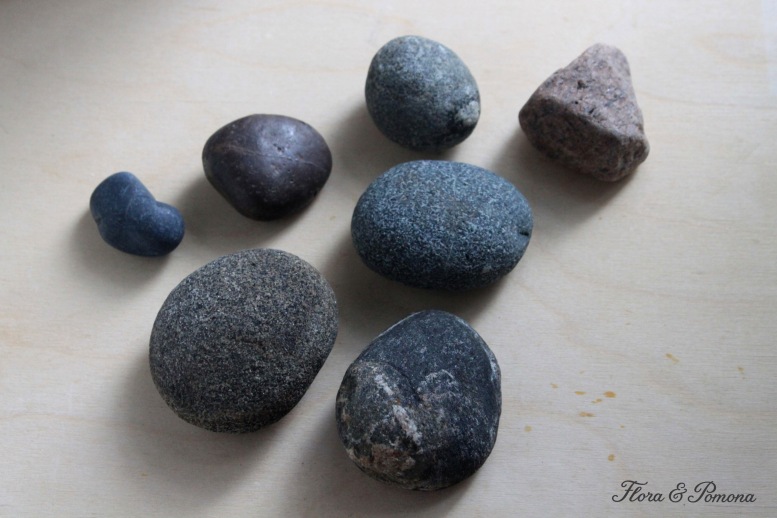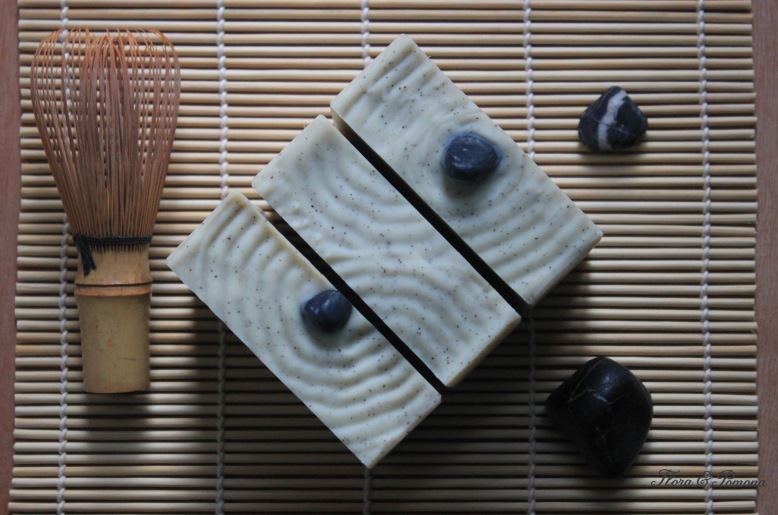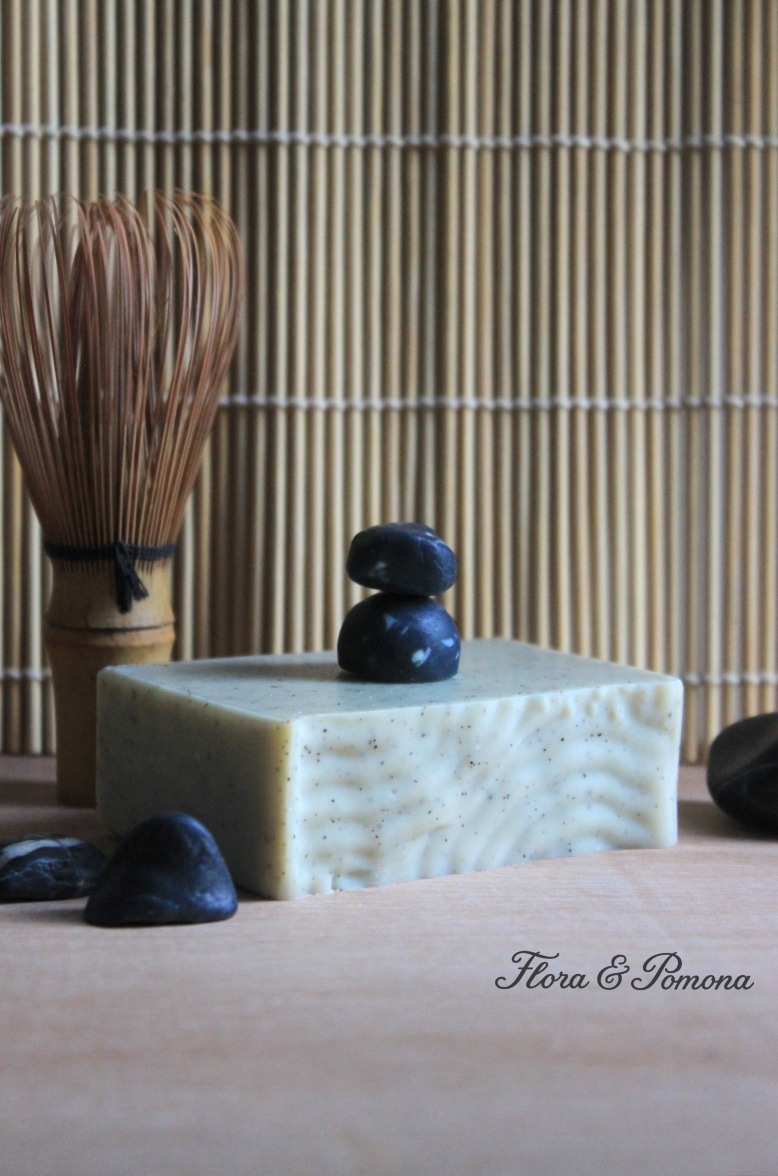The Japanese gardening tradition has a long rich history tracing back to as early as the 6th century. The concept of meditative gardening and the development of the Zen garden first appear in the 13th century after Japanese monks were introduced to Zen Buddhism. One of the most important aspects of Zen is that of the meditation-practice. Other contemplative arts in Japan, like Ikebana (flower arrangment), Kyudo (Zen archery) and Chanoyu (Tea Ceremony), are also rooted in this aspect of Zen.

I first started collecting rocks when I was about 8 or 9 years old and it was also at this age that I first visited Japan. I’ve been surrounded by Japanese culture most of my life, so the idea to make a Zen garden soap came about pretty naturally, once I decided to make soap stones. When making the Basalt Porphyry soap stones I set aside a small amount to make the pebbles with later. About the same time last year I made another gardening soap that turned our really well, so I decided to merge these two ideas and make a Japanese themed version of it. In this way was my soapy Zen garden was born.
During the process of planning this soap I got to thinking a lot about the idea of meditative gardening, and about how soap-making can also be a meditative practice.
In the Zen tradition, the art of gardening is not simply about gardens or even about artistry. This, I believe, is what makes the Japanese aesthetic approach so appealing. From wabi-sabi to shibui the Japanese aesthetic isn’t so much a principle, or even a philosophy, as it is a way of being in the natural world. So while the garden is indeed a visual poem – the raked sand is often a metaphor for waves and the stones, mountains – underlying these metaphors is the desire to reflect nature as it truly is, not as static but in motion. Even if the desire to represent and the act of reflecting both are, in a sense, artificial, the impulse is not to fix nature’s “imperfections” or exact your power over nature itself à la Versailles (with its square trees and geometric landscapes), but rather to create a microcosm of nature. This means choosing (or in my case, making) rocks and stones with imperfections, creating asymmetrical compositions and then allowing time and weather to effect these compositions.
The meditative-practice is an experience and a process. The sand is not raked and then cemented in place, it is raked over and over again, and this process is in itself a meditation. Any soap maker or any crafts person will recognize themselves in this practice: recreating the same soap, or kneading the clay, or the repetitive practice of knitting: you do it over and over, and yet it is never the same and eventually it comes to mean something else to you. It becomes ritual.
Part of this sentiment is also found in the west in the oft quoted “it’s not the destination, it’s the journey.” But it really is more significant than that, because the practice is a journey that never ends. Tea ceremony, flower arranging, raking sand in your garden, what these have in common is that through repeated ceremony of practice the common or natural world becomes transcendental. Rather than looking for that transcendental journey without a destination, you position yourself to never quite understanding the journey at all and to accepting that nothing is permanent. But you proceed nonetheless.
Keeping in line with the principle of asymmetry, I didn’t plan the placement of the soap rocks. While making the rake was easy, using it wasn’t! Raking the soap around the rocks turned out to be really difficult.

Raking the soap turned out to be more complicated that I anticipated, and was extremely frustrating at times. But I managed to keep calm and tried hard to accept the “imperfections” as simply part of theme of the soap. It’s all a learning process!
By seeing things for what they are and opening ourselves a unique moment in time that will never be had again (Ichi–go ichi-e, one time, one meeting), we are reminded to give thanks, to savor things and beings for their own essence: to observe the beauty of a rock, the scent of spring blossoms, or even perhaps, something as mundane as a well made bowl of tea, or why not, a bar of soap.

Making soap as a zen garden practice.
There’s something about soap making that makes me think of these meditative practices. Perhaps because when I make soap I am typically alone, or at least, quiet, engaging in a repetitive process that requires my full attention. It demands that you be mindful. Each handmade batch of soap and sometimes each bar is unique: it is a reflection of you and your thoughts, but like a zen garden or a flower arrangement, we then let it go. Soap is not a piece of art that you make and then enshrine. There is nothing sadder to a soap maker to see your soaps sit unused, and this is why I love crafting so much. It has little pretense, and is very practical. There is always a use for it, no matter how pretty they may be, or how well they are made and how much thought we put into them: we want them to be used. And we want to make more.
Not all soaps are made this way, or as a practice. For some the soap is all about the final product, and there is nothing wrong with that and it started this way for me as well. But the more I do it, the more it fascinates me, and I’ve come to cherish all the processes of the soap making: folding the parchment lining, stirring the oils, the moment of saponification, cutting and trimming each bar. I also enjoy working with natural materials that contain in them – like soap itself does – an element of unpredictability. Just like nature, all things of nature change, morph, fade, die, transform, and transcend. The surprise issued by the process of transformation is probably what soap makers love the most. There’s an alchemical element to this process. Just like there is in nature.

Zen Garden Soap: A gardener’s soap with three grades of cleansing grit – bentonite clay, pumice powder and jojoba seed powder – all set in a creamy base of organic fair-trade palm oil, organic coconut oil, organic unrefined shea butter, olive oil and organic cold pressed hemp seed oil. Scented with a woodsy blend of essential oils inspired by classical Japanese incense: organic Atlas cedar, Scotch pine, sandalwood aromatic essence, myrrh resin and eucalyptus globulus.






One thought on “Zen Garden Soap and the Zen of Soap Making”